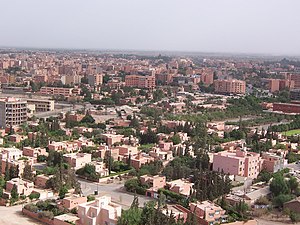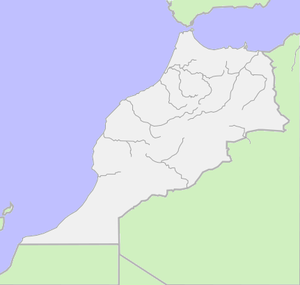Marrakech
From Wikipedia, the free encyclopedia
| Marrakech مراكش Murrākush |
|
| The City of Marrakech | |
| Location in Morocco | |
| Coordinates: | |
| Country | |
|---|---|
| Region | Marrakech-Tensift-El Haouz |
| Population (2006) | |
| - Total | 1,036,500 |
Marrakech or Marrakesh (Amazigh: Murakush, Arabic مراكش Murrākush), known as the "Red City", is an important and former imperial city in Morocco. It has a population of 1,070,838 (as of 2004),[1] and is the capital of the mid-southwestern economic region of Marrakech-Tensift-Al Haouz, near the foothills of the snow-capped Atlas Mountains.
Like many North African and Middle Eastern cities, Marrakech comprises both an old fortified city (the médina) and an adjacent modern city (called Gueliz). It is served by Ménara International Airport (RAK is the code for the airport) and a rail link to Casablanca and the north. Marrakech is the third largest city in Morocco after Casablanca and Rabat.[citation needed]
Marrakech has the largest traditional market (souk) in Morocco and also has one of the busiest squares in Africa and the world, Djemaa el Fna.[2] The square bustles with acrobats, story-tellers, water sellers, dancers, and musicians. By night, the square turns into food stalls, becoming a huge open-air restaurant with busy life.
Contents |
[edit] Name
The probable origin of its name is from the Amazigh (Berber) words mur (n) akush, which means "Land of God". (The root "mur" is used now in the Berber languages mostly in the feminine form "tamurt"). The same word "mur" appears in the country Mauritania, but this interpretation is still unproven to this day.
Until a few decades ago, Morocco was known as Kingdom of Marrakech by Arabs, Persians and Europeans. The European names of Morocco, Marruecos, Maroc, Marokko are directly derived from the Berber word Murakush. The city is spelled "Marrakech" in French, "Marrakech" or "Marrakesh" in English, "Marrakesch" in German and "Marakeş" in Turkish.
[edit] History

Prior to the advent of the Almoravids in the 11th century, the area was ruled from the city of Aghmat. The Almoravid leader, Abu-Bakr Ibn-Umar decided Aghmat was becoming overcrowded and chose to build a new capital. He decided to build it in the plains near the Tansift river. He chose the site of Marrakech, because it was in neutral territory between two tribes who were vying for the honor of hosting the new capital.[citation needed] Work started in May 1070, but Abu-Bakr was recalled to the Sahara to put down a rebellion in January 1071 and the city was completed by his deputy and eventual successor Yusuf ibn Tashfin.[3] The city experienced its greatest period under the leadership of Yacoub el Mansour, the third Almohad sultan. A number of poets and scholars entered the city during his reign and he began the construction of the Koutoubia Mosque and a new kasbah.
Prior to the reign of Moulay Ismail, Marrakech was the capital of Morocco. After his reign, his grandson moved the capital back to Marrakech from Meknès.
For centuries Marrakech has been known for its 'seven saints.' When sufism was at the height of its popularity, during the reign of Moulay Ismail, the festival of the 'seven saints' was founded by Abu Ali al-Hassan al-Yusi at the request of the sultan. The tombs of several renowned figures were moved to Marrakech to attract pilgrims in the same way Essaouira did at that time with its Regrega festivals. The 'seven saints' (sebaatou rizjel) is now a firmly established institution, attracting visitors from everywhere. The seven saints include Sidi Bel Abbas (the patron saint of the city), Sidi Muhammad al-Jazuli, Sidi Abu al-Qasim Al-Suhayli, Cadi Ayyad ben Moussa, Abdelaziz al-Tebaa and Abdallah al-Ghazwani.
Marrakech was dominated in the first half of the 20th century by T'hami El Glaoui, Lord of the Atlas and Pasha of Marrakech. The poet of the city was Mohammed Ben Brahim, his favorite place was café Al-Masraf. The poems and songs of Ben Brahim are still known by heart by many Marrakshi.
[edit] Demographics
Marrakech had an official number of population of 1,070,838 in 2004.[1] There is a very large international community consisting mainly of Europeans estimated at 10,700 people, mostly retired.[citation needed]
[edit] Main sights in Marrakech
Many tourists take a trip from Marrakech to visit the valley of the Ourika River in the Atlas Mountains or the valley of the Draa River in the south near the Sahara desert, but also to Middle Atlas Mountains: Waterfalls of Beni Mellal, and to Essaouira on the Atlantic ocean.
[edit] Transport
Menara International Airport serves as the main airport for the city and receives flights from Europe and neighboring Arab countries.
A toll-paying motorway connects Marrakech with Casablanca.
CTM coaches (intercity buses) and various private lines run services to most notable Moroccan towns as well as a number of European cities, from the Gare Routière on Rue Bab Doukkala in downtown Marrakech.
Marrakech is the southern terminus of the ONCF, the Moroccan railway network, and Marrakech is well served by trains heading to Tangier, Rabat, Casablanca, and Fes. The train station is located on Avenue Hassan II.
The ONCF owned "Supratours" bus company serves towns not served by the train. The bus timetable coordinates with the train timetable and the bus terminal is right beside the station.
[edit] References in popular culture
| Lists of miscellaneous information should be avoided. Please relocate any relevant information into appropriate sections or articles. (September 2008) |
- "Marrakesh Express" is a song by Crosby, Stills and Nash.
- "Marrakech" is a song by Incognito on their album No Time Like The Future (1999).
- "Marrakesh Night Market" is a song by Loreena McKennitt on her album The Mask and Mirror.
- Alfred Hitchcock filmed the opening scenes of The Man Who Knew Too Much (1956) on location in Marrakech with Doris Day and James Stewart.
- "Marrakech" is a song by ATB.
- In the PC game Dope Wars, players are offered a bargain deal on Hashish when the "Marrakech Express" arrives.
- Mentioned briefly in a conversation during the movie Raiders of the Lost Ark.
- Mentioned briefly in a conversation during the movie National Treasure 2: Book of Secrets
- George Orwell uses Marrakech as the title and setting of one of his essays
- "Marrakesh" is also a song by New Model Army.
- British progressive electronica duo Hybrid feature a song titled "Marrakech" on their album Morning Sci-Fi.
- Peter Kruder's debut solo album as Peace Orchestra also featured a track titled 'Marakesh'.
- The "Morocco" episode of the British sitcom Absolutely Fabulous is set in Marrakech. The episode was first broadcast in February 1994.
- The Extra Glenns (John Darnielle of The Mountain Goats fame and Franklin Bruno of Nothing Painted Blue fame) have a song titled "Going to Marrakesh" on their album Martial Arts Weekend.
- Marrakech doubled for 1920s Egypt in the 1999 film "The Mummy."
- Marrakech appeared in the 2000 game-of-the-year "No One Lives Forever." It appeared in the first mission in the first three stages.
- Mentioned in passing in episode 8 of The Venture Bros., Mid-Life Chrysalis as Team Venture's intended destination before being grounded.
- The book "Hideous Kinky", as well as its movie adaptation, are for a large part situated in Marrakech in the early 70's.
- In an episode in the third season of Family Guy, Stewie Griffin plays with his toy train and dreams about himself being a spy fighting another man on a train roof. When winning, Stewie says the line: "I don't think you'll be making it to Marrakech".
- "Marrakesh" is also a song by Goombay Dance Band (1981).
- "Marrakesh" is a single stanza poem by Scottish all-round writer - David Duguid, which describes his tribulations in trying to get to Marrakesh - the dream location.
- In series four, episode seven of The Apprentice UK, the remaining candidates went to Marrakesh in order to do a purchasing task.
- "Marrakech" is a title of a chapter, as well as the chapter's main setting, in James Michener's The Drifters
[edit] Sister cities
[edit] Climate
| Month | Jan | Feb | Mar | Apr | May | Jun | Jul | Aug | Sep | Oct | Nov | Dec | Year |
|---|---|---|---|---|---|---|---|---|---|---|---|---|---|
| Average high °F (°C) | 64 (18) |
67 (19) |
72 (22) |
74 (23) |
80 (27) |
87 (31) |
97 (36) |
97 (36) |
90 (32) |
80 (27) |
72 (22) |
66 (19) |
79 (26) |
| Average low °F (°C) | 43 (6) |
47 (8) |
50 (10) |
53 (12) |
57 (14) |
62 (17) |
69 (21) |
69 (21) |
66 (19) |
59 (15) |
52 (11) |
45 (7) |
56 (13) |
| Precipitation inches (mm) | 1.1 (27.9) |
1.2 (30.5) |
1.4 (35.6) |
1.3 (33) |
0.7 (17.8) |
0.3 (7.6) |
0.1 (2.5) |
0.1 (2.5) |
0.3 (7.6) |
0.8 (20.3) |
1.5 (38.1) |
1.1 (27.9) |
9.8 (248.9) |
| Source: [4] {{{accessdate}}} | |||||||||||||
[edit] Photo Gallery
|
The Saadian Tombs |
The Koutoubia Mosque |
Djemaa el Fna square by night |
|
|
city gate Bab Agnaou |
Marrakech riad courtyard |
||
[edit] References and notes
- ^ a b "Recensement Général De La Population Et De L'Habitat De 2004". hcp.ma. http://www.hcp.ma/pubData/Demographie/RGPH/Populationlegale(1).pdf. Retrieved on 2009-03-27.
- ^ Ready for the masses? - Daily Telegraph
- ^ Ibn Idhari, Al-bayan al-mughrib Part III, annotated Spanish translation by A. Huici Miranda, Valencia, 1963
- ^ weatherbase.com
- ^ Image credit
[edit] External links
| Wikimedia Commons has media related to: Marrakech |
|
|||||||


![Panoramic picture of the Djemaa el Fna[5] square at sunset. Koutoubia Mosque appears on the extreme left. The souks are in the alleys behind the square](http://upload.wikimedia.org/wikipedia/commons/thumb/9/94/Panoramic_Marakesh_square_Djemaa_el_Fna.jpg/1200px-Panoramic_Marakesh_square_Djemaa_el_Fna.jpg)













